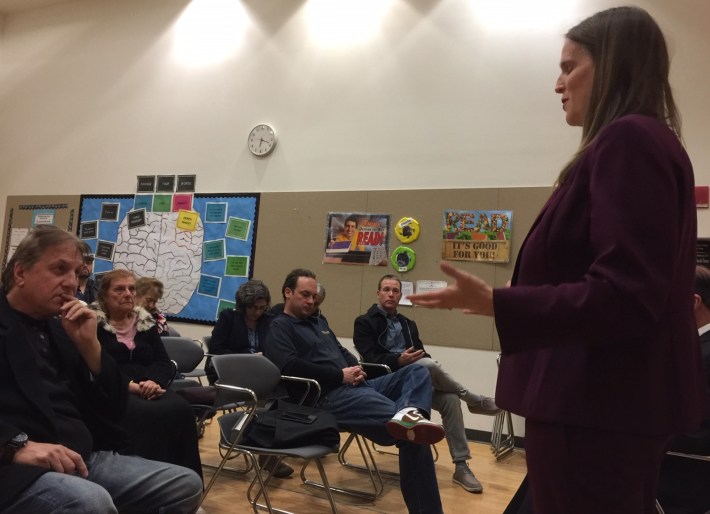Last night, Families for Safe Streets and Streetsblog L.A. hosted a town hall on L.A. City Council District 12 transportation issues. A crowd of about three dozen attended to hear city council candidates Loraine Lundquist (on the ballot) and Asaad Alnajjar (running as a write-in) face off. Incumbent L.A. City Councilmember John Lee did not attend.
FFSS and SBLA invited incumbent Lee multiple times but never heard back from his campaign. Lee won a run-off special election against Lundquist last August. It is widely anticipated that either Lee or Lundquist will win an outright majority in the upcoming March 3rd primary election - the same election as the presidential primary. To win the city council seat, a candidate needs 50 percent plus one vote. Since there are only two candidates on the ballot, it appears unlikely that the contest will move to a runoff in the November general election.
The event took place at the Northridge Branch Library. It was moderated by L.A. Walks Executive Director John Yi, with assistance from SBLA editor Joe Linton.
While there were certainly differences between the candidates present, both were repeatedly critical of the absent Councilmember Lee.
Asaad Alnajjar is a Porter Ranch resident who has worked as an engineer for the city of Los Angeles for over thirty years. In opening remarks he touted his roles in the city's ATSAC system, street widening, converting street lighting to energy efficient LEDs, and adding solar panels to street lights.
Loraine Lundquist is a Northridge resident. She is a scientist who teaches at Cal State Northridge. In opening remarks, she touched on the important overlaps between transportation and housing, environment, and safety. Lundquist generally stressed giving CD12 residents (and perhaps more broadly all Angelenos) more transportation options.
Taking the 364 bus to tonight’s Transportation Town Hall! pic.twitter.com/iWpjC5L7jP
— Loraine Lundquist (@LoraineForLA) February 6, 2020
Some of the biggest transportation issues in CD12 concern the existing Reseda Boulevard Great Streets project and Metro's upcoming North Valley Bus Rapid Transit.
In 2015, as part of the Great Streets program, a mile of Reseda Boulevard, in Northridge, received several improvements, including parking-protected bike lanes extending from Plummer Street to Parthenia Street. In December Councilmember Lee introduced a motion on Reseda Boulevard citing "ongoing complaints" and asking the city Transportation Department (LADOT) to conduct "a community opinion survey" and possibly "return to the original street design."
Alnajjar spoke generally in support of the Reseda Boulevard Great Streets project, from his experience having worked on it. He expressed disappointment that the project had not included free wi-fi access, as he had pushed for.
Loraine Lundquist expressed several times that, as a scientist, she "wants to see the data." When Lee proposed his motion, Lundquist sought out collision data from the Reseda Boulevard project, and found a "29 percent decrease in crashes." Lundquist said that an intersection just north of the project - at Reseda and Devonshire Street - is among the top five most dangerous intersections in California. She questioned the emphasis on speed over safety, stating her priority that L.A. needs to "take safety very seriously."
Lundquist was critical of Lee's motion, both because it was not backed up by data and because it was "not a real motion intended to pass." She called it "a political ploy... just pure showmanship... misleading this community," pointing out that Lee has not followed up by shepherding the motion through the necessary committee and council approvals.
In 2016, voters approved Metro Measure M funding for a North San Fernando Valley Bus Rapid Transit (BRT) line. As route details were narrowed down for environmental studies, some San Fernando Valley anti-transit folks rallied against the project, citing concerns over “massive traffic jams” and “giant apartment buildings.” In 2019, candidate John Lee campaigned heavily to "Stop the Nordhoff Bus Lane Project."
The first questioner from the audience last night asked Lundquist to clarify her position on the North San Fernando Valley BRT. Lundquist stated, "I have not chosen a particular route," but said that she wants "to look at all the data" including community input, "to do it right." Lundquist stated that "BRT is a really good transportation solution" but "not for everywhere." She went on to cite statistics that Nordhoff Street car lanes currently carry 9,000 people per day, and that, according to ridership projections, a bus lane would increase that capacity to 14,000 people per day.
Alnajjar spoke of being part of the city engineering team coordinating with Metro on this project, and proposed that a model that might work for SFV BRT would be having every third bus be an express bus.

For live-tweeting of the event, see the L.A. Times' Emily Alpert Reyes and CiclaValley.







